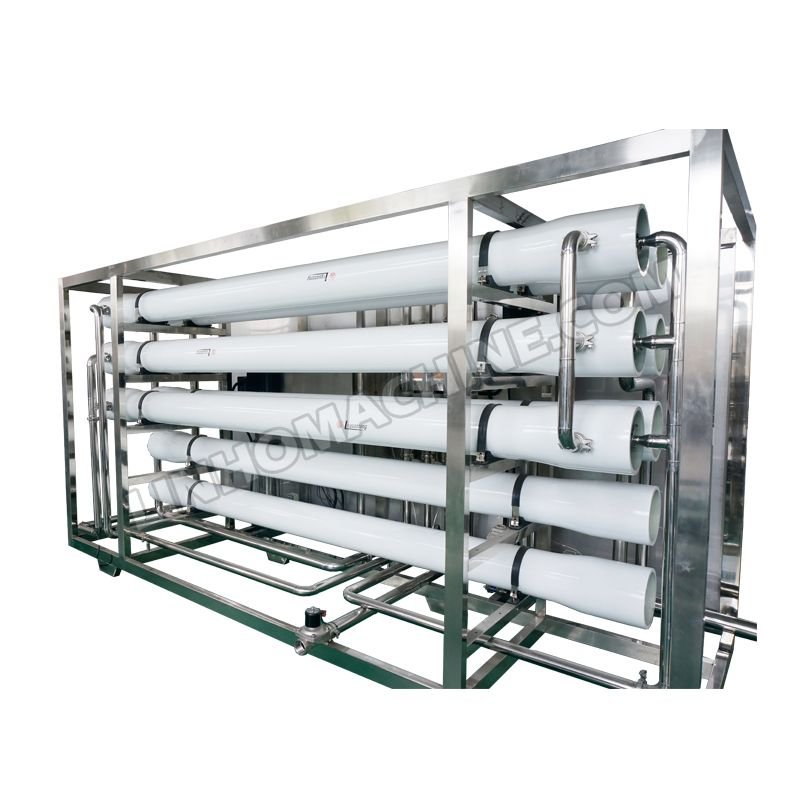Reverse Osmosis Water Treatment Plant
Compared With Other Water Treatment Methods, It Has The Advantages Of No Phase Change, Normal Temperature Operation, Simple Equipment, High Efficiency, Low Footprint, Convenient Operation, Less Energy Consumption, Wide Adaptation Range, High Degree Of Automation And Good Effluent Quality.
Additional information
| Production Capacity | 1,000-200,000L/h |
|---|---|
| RO Options | One Stage, Double Stage |
| Final Water TDS | <50 |
| Pure Water Output Rate | 60%-70% |
View Videos
Details of Reverse Osmosis Water Treatment Plant
USAGE
Food processing industry: food and vegetable processing, beer, beverages, mineral water
Chemical industry: Chemical reaction cooling, chemical reagents, fertilizers and fine chemicals, cosmetics manufacturing water
Textile printing and dyeing, paper, paint, water-based ink production
Electroplating coating industry: Automotive, home appliances, building materials and other products surface coating, glass coated water
Laboratory: Chemical Analysis, fluorescence analysis, detection and analysis, genetic research, etc.
RO Technology Introduction
Reverse osmosis is a membrane separation operation that separates solvents from the solution, driven by the pressure difference. Because it is contrary to the direction of natural penetration, it is called reverse osmosis. According to the different osmotic pressure of various materials, make the reverse osmosis pressure bigger than the osmotic pressure to achieve the purpose of separation, extraction, purification and concentration.
Reverse osmosis technology is the most advanced and energy-efficient membrane separation technology today. The principle is to use reverse osmosis pressure to separate these substances from water by the semi-permeable membrane. Because the membrane aperture of the reverse osmosis membrane is very small (only about 0.0001 microns), it can effectively remove dissolved salts, colloids, microorganisms, organic matter, etc. from the water (removal rate up to 97%-98%). Reverse osmosis is one of the most widely used desalination techniques in deionized water equipment, and its separation object is the ion range in solution and the organic matter of molecular weight hundreds of.
PURE WATER PRODUCTION TECHNOLOGY
Process 1: Tap water → original water tank → original water Pump → sand filter → carbon filter → water softener → security filter →RO high-pressure pump →RO membrane group → pure water tank
[pure water conductivity ≤10us/cm]
Process 2: Tap water → original water tank → original water Pump → sand filter → carbon filter → automatic dosing scale device → security filter →RO high-pressure pump →RO membrane group → pure water tank
[pure water conductivity ≤10us/cm]
Process 3: Tap water → original water tank → original water Pump → sand filter → carbon filter → automatic dosing and scale control device → security filter → first stage RO high-pressure pump → first-class RO membrane group →PH adjustment device → second stage RO pump → the second stage RO membrane Group → pure water tank
[pure water conductivity ≤5us/cm]

Share Reverse Osmosis Water Treatment Plant To Your
LINHO Filling Factory, established in 2012, is committed to manufacturing liquid filling machines. We aim to make the purchase of Chinese filling equipment fast and efficient. Explore now to view the newest releases from LINHO.
Links
- Small fillling solutions
- Warehouse equipment
Contact
- Industrial Park, Zhangjiagang
- +86 512 58186265
- +86 13372192902
- info@linhomachine.com
- Shanghai Airport








